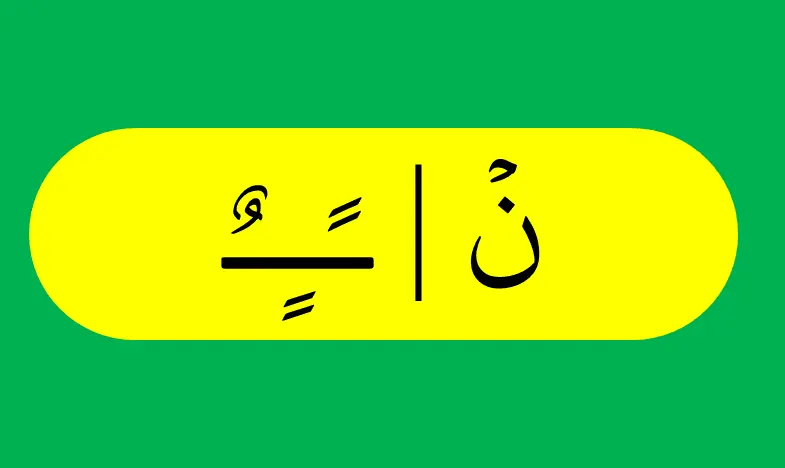noon sakinah rules is an original sakun nun, and it may be of the additions, devoid of movement, fixed in word, handwriting, connection, and stop, and it is in nouns, verbs, and letters, and it is intermediate in the word, and extreme, and its sign is sukun.
The meaning of the vowel-free nūn (i.e. it is not open, closed, or broken) and the fixed nūn (i.e. it is not omitted under any circumstances) verbally (i.e. it appears when pronouncing it), in writing (i.e. written in the Qur’an in its known form n), as a connection (i.e. in the connection) and as a stop (i.e. in endowment). Below we will learn about rules of noon sakinah in detail
What are the noon sakinah rules?
The noon sakinah rules is the non-moving nūn in the word, that is, the rules of noon sakinah is the non-moving nūn with fatha, dhamma, or kasra in the word. The rules of noon sakinah is an original or redundant nūn from the root of the word. The noon sakinah rules is the Noun that is silent in both pronunciation, calligraphy, connection, and stopping.
The rule of noon sakinah can be in nouns, verbs, and letters. For example, the noon sakinah in nouns (الأنْهار), the nun sakinah in verbs (فأنْذر), the nun sakina in letters (منْ). The sakānī nūn can also be in the middle of the word or at the end of the word. For example, the sakina nun in the middle of the word (سنْدس), the sakana nun at the end of the word (لنْ).
There are four noon sakinah rules, which are Izhar, Iqlab, Idgham, and Ikhfa. These noon sakinah rules are fulfilled if one of the letters of these rulings occurs after the sakun noun. The letters of Izhar are hamza, ha, ayn, ha, ghayn and kha.
Idgham is divided into two parts, Idgham with ghannah and Idgham without ghunnah. The letters of Idgham with ghannah are ya’, nun, meem, and waw, while the letters of Idgham without ghannah are lam and rā’.
The Iqlab has one letter, which is the ba. The Ikhfa letters are the remaining letters: Sad, Dhal, Tha, Kaf, Jim, Shin, Qaf, Sin, Dal, Ta, Zai, Fa, Ta, Daad, and Dha. Below we will discuss noon sakinah rules in detail.
The first ruling in the noon sakinah rules (Izhar)
The ruling on Izhar is considered the first ruling among the noon sakinah rules, and it is defined in the language as the statement, and in Tajweed terminology.
It is to take out each letter from its nostril without ghannah in the letter appearing, and some have defined it as the statement and clarity, and as for its letters, they are six letters; They are: the hamza, the ha, the ain, the ha, the ghayn, the kha.
Izhar in noon sakinah rules is called ḥalqiyyah; Because all its letters come out of the throat, and as for its reason after the exit; Because the noon sakinah and the noon tanween come out from the tip of the tongue, while the vowel letters come out from the throat, and there is nothing between them that requires assimilation.
Because assimilation is caused by similarity and closeness, and this does not exist in the letters of manifestation, and there is nothing that requires concealment; Because concealment only occurs with easy letters, and there is nothing that requires reversing, because reversing is a means of concealment, and thus it was revealed.
There are three levels of Izhar in noon sakinah rules, the highest; It is at the hamza and ha because they emerge from the farthest part of the throat and the middle. With the ain and the ha because they come out of the middle of the throat.
And the lowest level of Izhar is with the gheen and the kha because they come out from the bottom of the throat, and as for how to pronounce it; It is done by pronouncing the sakina nūn clearly and completely, without separation or silence, and an example of this is the word “
(وَالْمُنْخَنِقَةُ).
Izhar in noon sakinah rules occurs in one or two words, but if it comes in the tanween, it is only in two words, and the Izhar is given priority over the rest of the rulings because it is the original, and it was called that to show the silent nouns and the tanween when they meet one of its letters, and it was reported by some readers that the ghunnah remains in it, and examples of it include:
“عليماً”، “خبيراً”، “من عند”، “الأنهار”
The second ruling on noon sakinah rules (Idgham)
Idgham in noon sakinah rules is defined in the language as inserting something into something, and in terminology: it is inserting a consonant into a vowel, so that they become one stressed letter. Idgham in rules of noon sakinah has six letters grouped into the word: “يرملون” Assimilation is divided into two parts, the first: Baghna, and its letters are four.
And grouped in the word: “ينمو”, and this type only occurs in two words, and if it occurs in one word then the ruling is apparent, and the assimilation in one word came in four places in the Holy Qur’an, which are: “صنوان”, “قنوان”, “بنيان”, “الدُنيا”, and it is called Idgham ; Because assimilating it changes the meaning.
As for the second type, it is called Idgham without ghannah, and it occurs with the letters Lām and Rā’, and examples of it include: “أن لن ينقلب” “من ربهم” The assimilation is fully stressed in four letters: which are the Lām and Rā’ in agreement, and the Mīm and Nūn according to the stronger of the two possibilities, and it is set in the Qur’an. By placing severity on it, and stripping the waw and yā’.
Idgham in rules of noon sakinah also occurs in letters, as it occurs in the solar lam, such as the word: “والشمس” and the reason for the complete assimilation without ghana in the lam and the ra is the proximity of the exit of the nun and the tanween to each other.
And as for the letter nun, the vowel is similarity, and in the waw and yā’; The similarity between the ghūnah, the madd, and the liḥn, and in the meem, the assimilation indicates that they share the ghūnah, and examples of assimilation include: “من يقول” “من وال” “قولٌ معروف”
The third ruling in rules of noon sakinah Iqlab
Iqlab in rules of noon sakinah is defined in the language as turning something away from its destination, and in terminology: it is placing a letter in the place of another letter, so inverting the noon sakinah and tanween is a meem, and its letter is only a b. And the sakina noon, and the sharing of the ba and the meem in the same exit, and some characteristics.
The Iqlab in the Qur’an is determined by placing the letter meem above the letter nun, examples of which include: “من بعد”. The Iqlab is in the qalb of the noon sakinah and the tanween is in the pronunciation only while the ghunna remains.
And the Iqlab in noon sakinah rules may occur in one word or in two words, but as for the tanween it is only in two words, and when pronouncing it be careful not to press the lips on the inverted meem, rather it must be sung without heaviness.
The fourth rule of noon sakinah Ikhfa
Ikhfa in rule of noon sakinah is defined in the language as concealment, and in the terminology: it is the pronunciation of the letter in a manner between the manifestation, and the assimilation devoid of stress, with the ghannah remaining in the hidden letter.
The number of Ikhfa letters is fifteen letters, which are the rest of the letters except for the letters of manifestation, assimilation, and inversion, and it is in a word. In two words, it is pronounced in an intermediate state between the assimilation and the assimilation, with the ghanna remaining.
The reason for ikhfa is that the noun sakina and noon tanween did not produce the letters as close to the exit of the letters of concealment as their exit is to the assimilation letters. Ikhfa in rule of noon sakinah is divided into the closest letters, the furthest ones, and the middle ones, and examples of them include:
“أن صدوكم”، “عذاباً صعداً”، “من ذا”، “الأُنثى”
What is the difference between Nun Sakinah and Tanween?
- Definition of noon sakinah rules: The noon sakinah rules, or the original nun, is the fixed nun devoid of movement. It is fixed verbally, in writing, as a connection, and as a stop. These nuns are found in nouns, verbs, and letters. They either come in the middle of the word or are extreme, and their sign is sukoon, and these nuns are devoid of movement.
- Definition of tanween: Tanween is an additional noun that is at the end of the verbal word, but is separated from it by a line, that is, it is not written in its known form, such as: “كتابٌ” The vowels found at the end of the words that we mentioned are either the dhammah for the nominative or the two fatha for the accusative. Or the two kasra for the genitive, it is called Tanween,
Conclusion
At the end of the text, the noon sakinah rules are considered among the most important rulings in the science of Tajweed that a Muslim must master. In addition, the rules of noon sakinah are divided into four rulings that we have explained in detail. In addition, we mentioned the difference between the rule of noon sakinah and Tanween.




